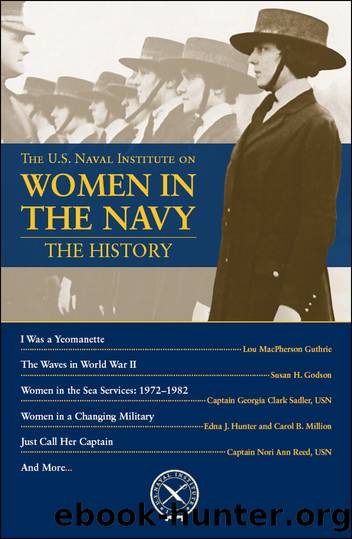The U.S. Naval Institute on Women in the Navy by Thomas J Cutler

Author:Thomas J Cutler
Language: eng
Format: epub
ISBN: 9781612519852
Publisher: Naval Institute Press
Published: 2015-11-17T00:00:00+00:00
Changes in Policy and Law
The policy message on women issued by the Chief of Naval Operations, Admiral Elmo R. Zumwalt, Jr., in August 1972 was a watershed for women in the Navy. In that message, Z-gram 116, Admiral Zumwalt indicated that while women in the Navy had historically played a significant role, he believed the Navy could do far more than it had to accord women equal opportunity. He also recognized the heightened importance of women as a vital personnel resource in the all-volunteer force. As a direct result of this Z-gram, many new fields and opportunities opened to women. Limited entry of enlisted women into all ratings was authorized, and a pilot program was initiated for the assignment of women to the crew of the hospital ship Sanctuary (AH-17). Women began to be assigned as commanding officers and executive officers at shore activities. All the staff corps and restricted line communities were opened to women, as was the NROTC program. The pattern of assigning women exclusively to certain billets was eliminated, and qualified women were to have tours covering the full spectrum of challenging and highly career-enhancing billets, including briefers, aides, executive assistants, service college faculty members, action officers on the CNOâs staff and the Joint Staff, senior enlisted advisors, etc. Women were also to be assigned to duty at more operational types of commands, for example, major fleet and type commanders, operational training commands, and antisubmarine warfare tracking facilities. Joint service colleges were to have Navy women as students and faculty members. As a personal illustration of these changes, almost every assignment the author has had since 1972âinstructor at the Naval Academy, intelligence briefer to the Chairman of the Joint Chiefs of Staff, action officer on the Joint Staff, and student at the National War Collegeâwould have been impossible prior to Z-gram 116.
The major policy change for women in the Marine Corps occurred in 1974 with their assignment to units in the Marines Forces (FMF). In the early 1970s, the Marine Corps, like the other services, was having difficulty recruiting the quantity and quality of men it required. The shortages were especially critical in the technical occupations, many of which were in the FMF. Meanwhile, the number of women was increasing, and some of those women were entering the technical skills. The Marine Corps, therefore, decided that at least part of the shortages in the FMF could be made up by employing women in units not routinely exposed to combat action. A pilot study in 1974 called for the eventual assignment of about 70 officers and 450 enlisted women to the FMF; by the end of this year, 13 women were assigned to nine units. A follow-on review in 1977 indicated that the FMF could utilize up to about 3,700 women. By 1982, the number of women assigned to combat support and combat service support units in the FMF had grown to almost 600 women in 39 units.
For the Coast Guard, the major policy changes came in 1977 and 1978.
Download
This site does not store any files on its server. We only index and link to content provided by other sites. Please contact the content providers to delete copyright contents if any and email us, we'll remove relevant links or contents immediately.
The Radium Girls by Kate Moore(11621)
100 Deadly Skills by Clint Emerson(4689)
The Templars by Dan Jones(4557)
Rise and Kill First by Ronen Bergman(4544)
The Doomsday Machine by Daniel Ellsberg(4245)
The Rape of Nanking by Iris Chang(4022)
Killing England by Bill O'Reilly(3896)
Hitler in Los Angeles by Steven J. Ross(3798)
Stalin by Stephen Kotkin(3724)
12 Strong by Doug Stanton(3419)
Hitler's Monsters by Eric Kurlander(3162)
Blood and Sand by Alex Von Tunzelmann(3055)
Darkest Hour by Anthony McCarten(3018)
The Code Book by Simon Singh(2856)
The Art of War Visualized by Jessica Hagy(2837)
Hitler's Flying Saucers: A Guide to German Flying Discs of the Second World War by Stevens Henry(2624)
Babylon's Ark by Lawrence Anthony(2427)
The Second World Wars by Victor Davis Hanson(2421)
Tobruk by Peter Fitzsimons(2374)
